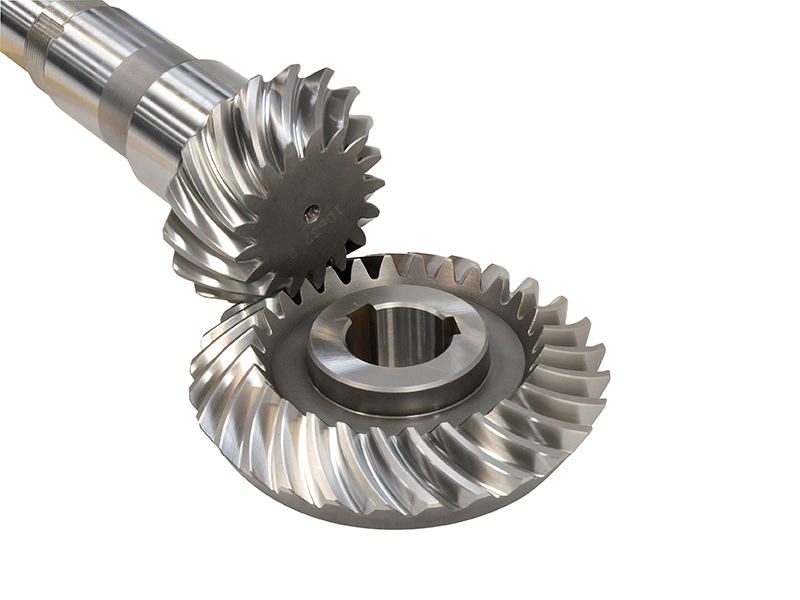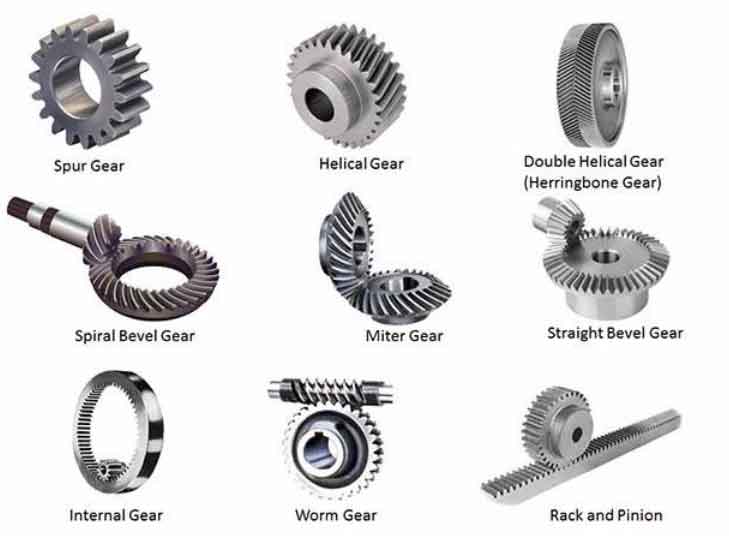Product Description
miniature small helical Stainless Steel Sintered Metal plastic spiral miter straight 90 degree Forged straight zerol forging bevel gear gears
Application of bevel gear
Bevel gears are used in a wide variety of applications, including:
- Automotive: Bevel gears are used in automobiles to transmit power from the engine to the wheels. They are also used in electric vehicles to control the speed of the electric motor.
- Aerospace: Bevel gears are used in aircraft to control the speed of the propellers or fans. They are also used in spacecraft to control the speed of the rocket engines.
- Construction: Bevel gears are used in construction equipment such as excavators, cranes, and loaders to control the speed and torque of the machinery.
- Manufacturing: Bevel gears are used in manufacturing equipment such as conveyors, pumps, and turbines to control the speed and torque of the equipment.
- Other applications: Bevel gears can also be used in a variety of other applications, such as robotics, wind turbines, and electric vehicles.
Bevel gears are an essential part of many machines and devices. They help to ensure that the rotating shafts operate smoothly and efficiently.
Here are some of the advantages of using bevel gears:
- Can transmit power between shafts that are not parallel: Bevel gears can transmit power between shafts that are not parallel, which makes them ideal for applications where the shafts are at an angle to each other.
- Can transmit high torque: Bevel gears can transmit high torque, which makes them ideal for applications where a lot of power needs to be transferred.
- Compact size: Bevel gears are relatively compact, making them ideal for applications where space is limited.
- Long life: Bevel gears can last for many years with proper maintenance.
Here are some of the disadvantages of using bevel gears:
- Cost: Bevel gears can be more expensive than other types of gears.
- Maintenance: Bevel gears require periodic maintenance, such as lubrication and inspection.
- Failure: Bevel gears can fail, which can lead to downtime and repairs.
Overall, bevel gears are a versatile and reliable type of gear that can be used in a wide variety of applications. They offer a number of advantages over other types of gears, but they also have some disadvantages. The best type of bevel gear for a particular application will depend on the specific requirements of that application.
/* January 22, 2571 19:08:37 */!function(){function s(e,r){var a,o={};try{e&&e.split(",").forEach(function(e,t){e&&(a=e.match(/(.*?):(.*)$/))&&1
| Application: | Motor, Electric Cars, Motorcycle, Machinery, Marine, Toy, Agricultural Machinery, Car |
|---|---|
| Hardness: | Hardened Tooth Surface |
| Gear Position: | Internal Gear |
| Manufacturing Method: | Cast Gear |
| Toothed Portion Shape: | Spur Gear |
| Material: | Stainless Steel |
| Samples: |
US$ 9999/Piece
1 Piece(Min.Order) | |
|---|
How do spiral gears contribute to reducing noise and vibration?
Spiral gears contribute significantly to reducing noise and vibration in gear systems. Their unique design and characteristics help minimize unwanted sound and vibrations. Here's how spiral gears achieve noise and vibration reduction:
- Gradual Tooth Engagement: Spiral gears have a helical tooth arrangement, which results in gradual tooth engagement as the gears mesh. Unlike spur gears with instantaneous full tooth contact, the helical teeth of spiral gears gradually come into contact, reducing the impact and shock during gear meshing. This gradual engagement helps to minimize noise and vibration.
- Improved Contact Pattern: The helical tooth profile of spiral gears produces a favorable contact pattern between the teeth. The contact pattern is more evenly distributed across the tooth face compared to spur gears, which reduces stress concentration and potential noise generation. The improved contact pattern contributes to smoother and quieter gear operation.
- Load Distribution: Spiral gears distribute the load over multiple teeth due to their helical shape. This load distribution helps to minimize localized stresses and reduces the risk of tooth breakage or pitting, which can contribute to noise and vibration. By spreading the load across a larger contact area, spiral gears ensure smoother and more stable gear operation.
- Reduced Sliding Friction: The sliding friction between gear teeth can generate noise and vibration. Spiral gears, with their helical tooth profile, exhibit reduced sliding friction compared to spur gears. The sliding motion is distributed along the helical path, resulting in smoother tooth contact and reduced friction-induced noise and vibration.
Collectively, these factors—gradual tooth engagement, improved contact pattern, load distribution, and reduced sliding friction—contribute to the noise and vibration reduction achieved by spiral gears. This makes them particularly suitable for applications where quiet operation and minimal vibration are essential, such as precision machinery, automotive transmissions, and other noise-sensitive environments.
What are the benefits of using spiral gears in high-torque applications?
Spiral gears, also known as helical gears, offer several benefits when used in high-torque applications. These advantages make them well-suited for transmitting large amounts of torque efficiently and reliably. Here are the key benefits of using spiral gears in high-torque applications:
- High Load Capacity: Spiral gears are designed to handle high loads and transmit significant amounts of torque. The helical tooth arrangement allows for load distribution across multiple teeth, reducing stress concentration on individual teeth. This design feature enables spiral gears to withstand the heavy forces encountered in high-torque applications.
- Smooth and Efficient Power Transmission: The helical shape of the teeth in spiral gears enables smooth and continuous contact between the mating gears. This gradual tooth engagement results in reduced impact and vibration during gear meshing. Additionally, the helical tooth profile minimizes sliding friction, leading to efficient power transmission and reduced energy losses, which is particularly important in high-torque applications where power efficiency is crucial.
- Reduced Noise and Vibration: The gradual tooth engagement and improved contact pattern in spiral gears contribute to reduced noise and vibration during operation. The helical tooth arrangement helps to distribute the load more evenly, minimizing dynamic forces and resulting in quieter gear operation. This is especially beneficial in high-torque applications where noise reduction is desired, such as precision machinery or noise-sensitive environments.
- Axial Thrust Compensation: Spiral gears can be designed with opposite helix angles on mating gears, which helps cancel out the axial thrust generated during gear meshing. This feature is particularly advantageous in high-torque applications where managing axial forces is critical. By eliminating or reducing the axial thrust, spiral gears simplify the gear design and reduce the need for additional components, such as thrust bearings.
- Reliability and Durability: The robust design of spiral gears, combined with their ability to handle high loads and transmit torque efficiently, contributes to their overall reliability and durability in high-torque applications. The gradual tooth engagement, load distribution, and reduced friction help minimize wear and extend the service life of the gears, ensuring long-term performance under demanding conditions.
These benefits make spiral gears an excellent choice for high-torque applications where reliable and efficient power transmission, smooth operation, reduced noise, and durability are essential requirements.
What are spiral gears and how are they used in machinery?
Spiral gears are a type of cylindrical gears with teeth that are curved in a spiral pattern. Unlike straight-cut gears, which have teeth that are parallel to the gear axis, spiral gears have teeth that are angled or helical. This helical tooth arrangement provides several advantages in terms of performance and noise reduction.
Spiral gears are commonly used in machinery for various applications due to the following reasons:
- Smooth and Quiet Operation: The helical tooth arrangement of spiral gears enables gradual tooth engagement, resulting in smoother and quieter operation compared to straight-cut gears. The angled teeth allow for gradual contact, reducing noise and vibration during gear meshing.
- Increased Load Capacity: The helical tooth design of spiral gears distributes the load over multiple teeth, increasing the load-carrying capacity. This makes spiral gears suitable for applications that require high torque transmission and heavy-duty operations.
- Improved Efficiency: The helical tooth arrangement of spiral gears helps in minimizing sliding friction between the teeth. This results in a higher level of efficiency compared to straight-cut gears, as there is reduced power loss due to friction during gear operation.
- Axial Thrust Compensation: Spiral gears can be designed with opposite helix angles on mating gears, which helps in canceling out the axial thrust generated during gear meshing. This feature eliminates the need for additional thrust bearings, simplifying the gear design and reducing complexity.
- Versatility: Spiral gears can be manufactured in various configurations, including spur, helical, and double helical designs. This versatility allows for their application in a wide range of machinery, including automotive systems, industrial equipment, and power transmission systems.
In machinery, spiral gears are commonly used in applications that require smooth operation, high load capacity, and efficient power transmission. Some examples include gearboxes, automotive differentials, machine tools, and heavy-duty industrial machinery.
Overall, the unique tooth geometry of spiral gears makes them a preferred choice in many machinery applications, offering improved performance, reduced noise, and enhanced load-carrying capabilities.
editor by Dream 2024-04-29




